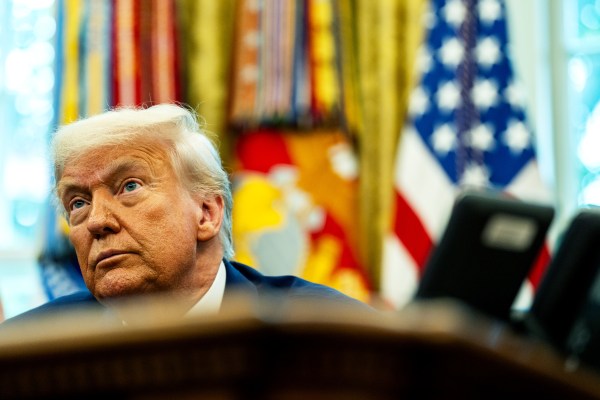Let’s get my unpopular opinion out of the way first: I don’t think high voter turnout is a good thing.
Do I think you, gentle readers, should vote? Sure! If you have the interest in American government and politics to be reading my tappings for The Dispatch on a Monday morning in the middle of August, you’re exactly the kind of person I hope is a very active voter, whatever your politics. Indeed, I think we should make voting a much bigger deal: a national Election Day holiday every other year, including a four-day weekend, rather than the monthlong dribble of early and absentee voting that has evolved over the past four decades.
Between awful primary elections stretching from February through September and the six-week general election, America is subjected to a 10-month ordeal of pandering, attack ads, and fake controversies. We stew in the dumpster juice of our patronizing politics and then wonder why things don’t smell April fresh.
I have too often stated my objections to America’s odious primary election system, a 45-year experiment, the failure of which is likely unsurpassed by any of the causes of the afflictions of our civic life. But here I go again: While the incentives for extremism and negative partisanship are the worst parts, a close second is that our two parties subject the whole country to what is actually an internal matter. Deciding which starting players the blue team and the red team pick should not drain the time, attention, and resources of state and local governments. If I could, I’d outlaw state-sponsored primaries today and make the parties choose their own candidates and leave the rest of us the heck out of it. Here endeth the harrumphing.
So, when I say that voter turnout isn’t a good thing, I don’t mean that voting itself or democracy are bad things. Indeed, I wish we had a more appropriately reverent attitude toward our great inheritance of self-government. I would love it if more Americans felt privileged to be able to cast their ballot, knowing how rare a blessing government of, for, and by the people really is. The fact that so many Americans think so little of their right to vote that they neglect it is a sad reflection of the apathy that has been a byproduct of our extraordinary success. But that’s not the same as saying that higher turnout is a good thing unto itself.
A couple of the free, prosperous, well-administered nations of the world have mandatory voting, notably Australia and Belgium. But most of the rest of the nations on the list are not exactly gold-star winners for civics and liberty, including Brazil, Turkey, and Egypt. Turkey has two-and-a-half times higher voter turnout than vote-if-you-want to Switzerland, but I doubt many Swiss would switch their system for the Turks’. It’s true that many of the high-turnout countries with voluntary voting are free, peaceful, and prosperous, notably Israel and the Scandinavian nations, but I’d posit that their participation rates are far more a product of beneficial social cohesion than a cause of it. I’d hope you’d at least agree that there’s no clear correlation between high turnout and good government.
So, for most of the past 25 years, when do-gooders would wail about the scourge of low-turnout elections, I mostly rolled my eyes. Voter apathy has many causes, but the main ones are seeming opposites: disillusionment and contentment. People are less likely to vote when they don’t think that it makes a difference: that change is not possible, the system is rigged, there’s no real difference between their choices, etc. But people are also less likely to vote when they’re happy with the status quo. In fact, both things can be true at the same time: Voters who aren’t upset with the way things are going but who also don’t think their voice matters in the system. That’s a perfect recipe for disengagement.
The highest turnout presidential elections in American history were in 1860 and 1872. The first one led to the Civil War and the second one almost did again. The lowest turnout presidential elections were in 1996 and 1948, both following world-historic American victories abroad and during eras of major economic expansion and optimism. In the turbulent 21st century, it is not surprising that voter turnout has been substantially higher than it was in the peaceful, prosperous 1980s and 1990s. It also follows that the election of 2020, conducted amid a pandemic, social unrest, and as the sitting president was trying to steal a second term in plain sight, would be the highest turnout presidential contest in more than 100 years. High turnout tends to be correlated to dissatisfaction and anxiety. Contrary to the hopes of do-gooders in every secretary of state’s office and the League of Women Voters, most Americans would prefer the outcomes when turnout was 15 points lower a generation ago to our era of high engagement.
But that doesn’t mean that low turnout is a good thing, either.
Our modern parties developed their divisive approach to winning elections by mobilization, not persuasion, in part because it was so hard to get normal people to the polls, especially in midterm elections. Just half of eligible voters participated in the 2018 midterms, but that was still more than in any midterm since 1914 and about 10 points higher than any midterm since 1972. If only two in five potential voters take part, guess who is staying home and who is showing up? There is an obvious, strong correlation between partisan intensity and voter participation.
It’s also self-reinforcing. If candidates and parties depend on base mobilization to win low-turnout elections, the issue sets and the campaign tactics will be more likely to turn off moderate or persuadable voters. Back to the roots of apathy: If you think both candidates are the pits, what’s getting you down to the local elementary school gymnasium to vote? When moderates drop out, the value of the partisan nuts goes up. Plus, base motivation is easier and less risky than persuasion. Your own core voters may abandon you if you’re reaching out to the middle, so why chance it if you can win in a base-vs.-base grudge match.
But that approach isn’t working in our time of increased voter engagement. Overall dissatisfaction with the state of things—including politics itself—is driving more normal people to the polls, but the parties themselves are still very much arranged around the idea of motivation over persuasion. Add in the perverse incentives of our primary system, and you have two entities ill-equipped to speak to the voters who have entered the process in search of sanity and success.
The parties born of the low-turnout era have produced an atmosphere that has pushed previously apathetic voters into action. Now, the race is to see which team can figure out how to answer those demands. Then things can calm down and turnout can drift back down to the happy apathy of peaceful times.







Please note that we at The Dispatch hold ourselves, our work, and our commenters to a higher standard than other places on the internet. We welcome comments that foster genuine debate or discussion—including comments critical of us or our work—but responses that include ad hominem attacks on fellow Dispatch members or are intended to stoke fear and anger may be moderated.
With your membership, you only have the ability to comment on The Morning Dispatch articles. Consider upgrading to join the conversation everywhere.